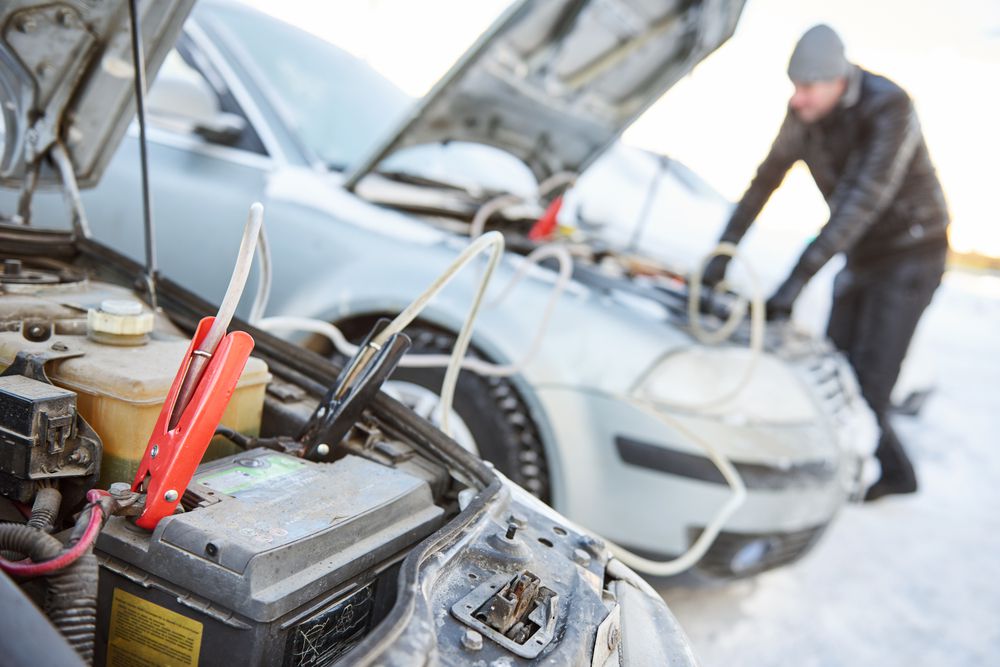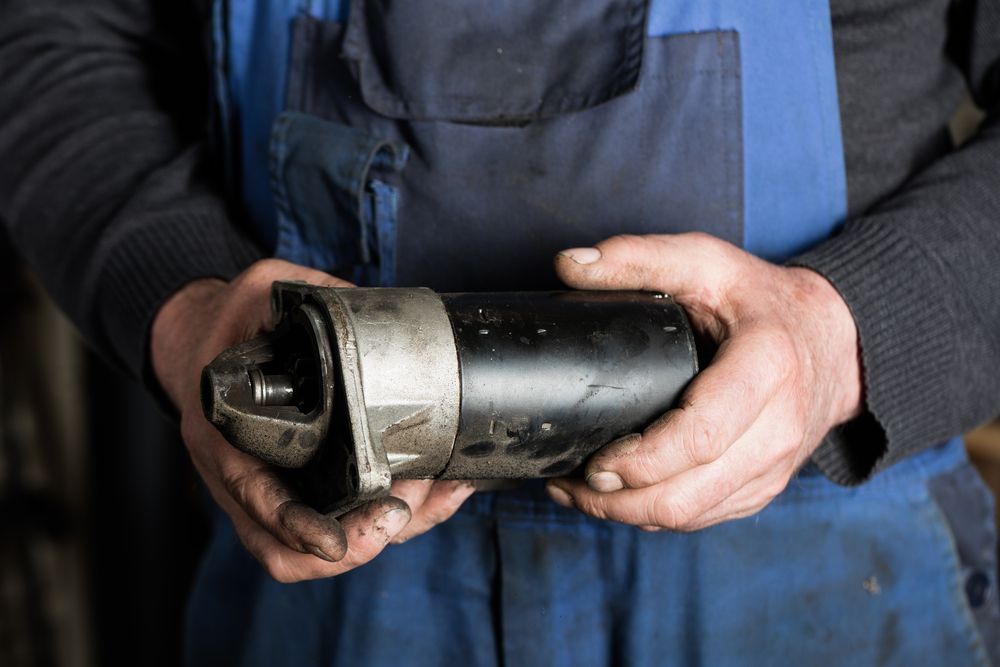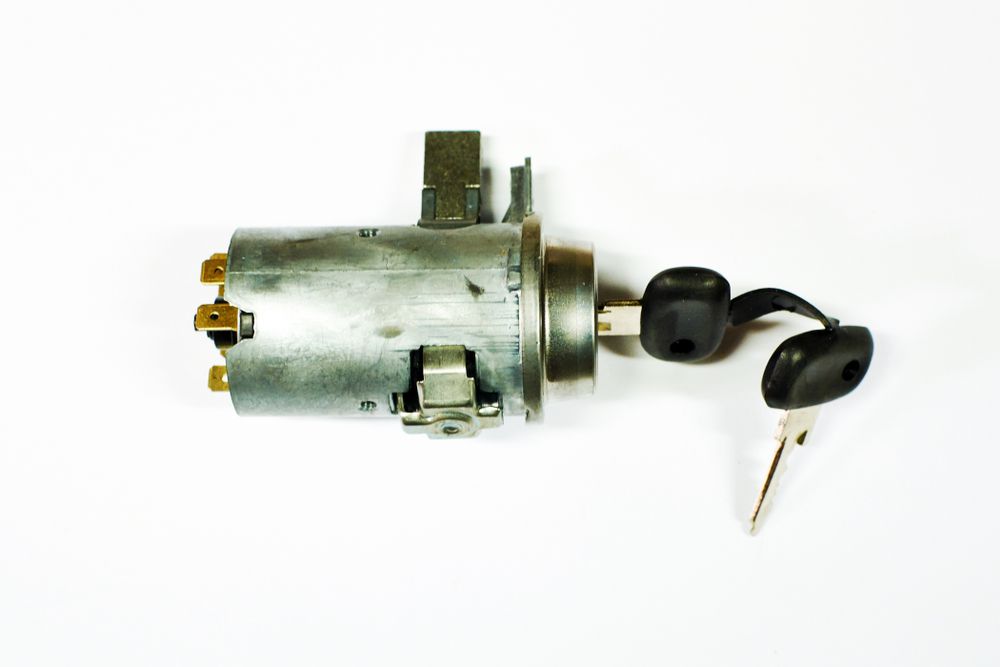Although you can jump-start a car with a bad starter just as you would a car with a good starter, it isn't necessarily going to improve your chances of getting your car started.
Jump starting a car with a dead battery and a starter that is beginning to fail, but still works intermittently, can improve the chances that the starter will have the juice it needs to turn the car over when it does indeed work.
Remember that it may not be the starter causing the issue — some battery and alternator problems sound similar to bad starters.
We'll discuss the signs of a bad starter, the sounds it might make, and more below.
 Jump starting a car.
Jump starting a car.
Jump Starting a Car with a Bad Starter?
So, can you jump-start a car if the starter is out?
It's good to be familiar with jump-starting a vehicle in the event of a dead battery ahead of time, so you can take a look through your owner's manual to learn the basics.
There are a few things to keep in mind when it comes to jump-starting a car with a bad starter.
The first thing is jump-starting a car with a good battery, but a bad starter won't start your car. If your battery is good, you need to get the starter fixed if you want your car to start.
However, often a faulty starter will still work intermittently, one out of five or one out of every ten times, for example. In this case, if the battery is weak or dead, it can still be beneficial to jump-start the vehicle because once the starter properly engages, it will have the juice needed to crank the engine strong enough to start.
Often the electrical components in the starter circuit fail due to overheating from excessive cranking, so if you are having trouble starting your vehicle, give your starter time to cool down between start attempts.
 Mechanic with an old starter.
Mechanic with an old starter.
What Does a Dead Starter Sound Like?
If your vehicle doesn't start, you'll want to troubleshoot the problem correctly so you don't waste time and money trying to fix something that isn't broken.
Often a dead battery, malfunctioning starter, and bad alternator can have similar symptoms when they fail.
One way to determine the problem is by the sound the vehicle makes when you are trying to start it.
Below are some sounds a starter can make as it begins to fail:
- Whirring — When you turn the key, the starter motor spins and the starter's gear should extend to engage the flywheel teeth. If this doesn't happen or the gear won't engage for very long, a whirring sound (think electric fan or vacuum cleaner) occurs.
- Grinding — It's one of the most common sounds signaling a bad starter, happening when the motor fails to mesh with the flywheel teeth properly. Stop cranking the engine as soon as you hear the noise, as prolonged attempts could break the teeth, causing costly repairs.
- Clicking — You'll hear clicking when you turn the ignition key, and the starter gear can contact the flywheel but can't engage. Luckily, you can usually solve intermittent failures like these by trying again. However, don't try too many times; otherwise, you could overheat the starter and cause more damage and potentially a fire.
- Silence — If you hear nothing when turning the key, it could be a sign of a bad starter solenoid or starter relay. Although also, check the battery, and ensure the battery terminals and ground connections are clean and well secured.
- Slow Crank - Failing starter motors often sound like weak batteries when trying to crank your car over. Again check the battery as well.
- Marbles in a Tin — A persistent grinding noise can occur if the starter doesn't disengage after the vehicle has started. You need to take it to a mechanic to get it fixed as soon as possible before it becomes a fire hazard.
How to Test If Starter is Bad
Before diving deeper into your "will a bad starter start with a jump" question, you must ensure the starter is broken.
You can use various methods to narrow your problem to a faulty starter, and we'll run through them here quickly.
The basics of a starter are the starter motor, starter solenoid and/or relay, and flywheel mechanism.
Starter system issues are common, but many drivers confuse them with other problems with the car's electrical system.
The first thing to do is test your charging system and ensure you have enough battery power to turn the motor over fast enough to start it up. Also, check your starter fuse.
You can test the battery and alternator with a multimeter as laid out here. Other signs of a dead battery include no interior lights and weak or dead headlights.
If your battery is good, the next step will be to test the starter. The best way to test a starter is to run a series of bench tests requiring that the starter be removed from the vehicle.
Bench tests require basic tools and a mechanical knowledge or willingness to learn. Thankfully there are countless youtube tutorials to help you out.
Perform a bench test like this:
- Remove the starter — Carefully disconnect the wiring and extract it from the engine block. Ensure you do this carefully or leave it to a professional if you aren't confident. Remember to keep track of all the bolts and wires for reassembly.
- Attach jumper cables — Connect the red jumper cable to the positive terminal of a car battery. Attach the other end to the positive post on the starter's solenoid. Put the black jumper cable on the starter's ears and the other end to the battery's negative terminal.
- Connect a wire — Strip one end of the insulated 16-gauge wire. Crimp it onto the starter's small terminal. Strip the other end in preparation.
- Secure the starter in a vice — Keeping it in place prevents it from flailing around and causing injuries.
- Touch the wire to the battery post — Attach the other end of the stripped wire to the positive battery post.
At this point, the starter pinion should spin and move. If not, the starter is faulty and requires replacement.
How Do You Tell If It's Your Starter or Your Battery?
If you hear a clicking sound when you start your car, but it won't turn over, this could signal a dead battery instead of a faulty starter.
To confirm, jump the vehicle and switch the car off again.
If it ran but wouldn't turn over again after it's shut off, you have a dead battery on your hands.
Luckily, this isn't just the easiest to replace; it's also the cheapest.
You can run a few easy tests before removing the starter for bench testing.
Here's how to do it:
- Turn the headlights on and try to start the vehicle — If the car makes a sound as it might start, but the headlights flicker or dim, the starter pinion might be jammed. If it clicks but never sounds like it might start, it's probably the battery (skip to step three in this case).
- Adjust the pinion stub — The small, square stub protruding from the end of the cylinder is called a pinion stub. Use a wrench until it moves into place, and try starting the car again. If you can't see a stub and have a manual transmission, put the car in second gear, release the emergency brake, and rock it to loosen the pinion.
- Inspect the battery terminals — Corrosion or dirt can cause bad connections, preventing enough power from reaching the starter. Disconnect the battery and clean the connections with a wire brush if necessary.
- Test battery voltage — Set a multimeter to the "DC" setting and twist the dial to 20. Put the red probe on the positive terminal and the black on the negative. A reading above 12V will appear if it's usually working.
- Inspect the solenoid — If the battery is working, but the car still won't start, it might be a solenoid (i.e., the little cylinder connected to the starter's top) problem. Visually inspect the wires to ensure they're connected.
- Check solenoid input current — Put one circuit tester leader on the feed terminal and attach the other to bodywork metal. If the tester lights up, the issue is with the starter or solenoid rather than the current.
- Check solenoid output current — Put the test lamp on the solenoid's output and the other on the battery's ground terminal. If the lamp doesn't light, bench test the starter.
How Do You Tell If You Need a New Alternator or Starter?
A bad alternator will lead to a dead battery, so you can try jump-starting the vehicle to test if you need a new alternator or starter.
If the vehicle starts fine when jump-starting, it points to a problem with your charging system, which includes the alternator.
Can You Jump Start a Car with a Bad Alternator?
Jumping a car with a bad alternator will keep it running for a while, regardless of the alternator's condition, provided you have a good battery.
 Old ignition switch
Old ignition switch
Can You Jump Start a Car with a Bad Ignition Switch?
You can jump-start a car with a bad ignition switch by connecting directly from the positive terminal on the battery to the starter solenoid, which will effectively bypass the bad ignition switch.
Can You Jump Start a Car with a Bad Starter Relay?
Jump starting a car with a bad starter relay is relatively straightforward if you know what you are doing. The start relay is typically located in the fuse box. You can pull the starter relay out of the fuse box and replace it with a jumper cable.
Conclusion
You can jump-start a vehicle with a bad starter, but it won't necessarily make the starter work. However, suppose the starter is still working intermittently, and the battery is weak. In that case, jump-starting the vehicle may help start the vehicle so you can get the vehicle moved to a location where you can get the starter repaired.